American Institute for Medical and Biological Engineering (AIMBE) Public Policy Institute for Rising Leaders attended by BME's Lindsey Stewart
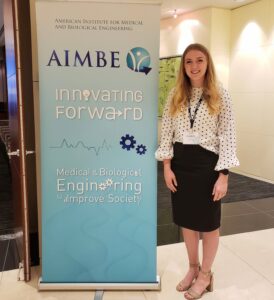
We are so proud of our student, Lindsey Stewart for taking advantage of this incredible opportunity. Read more about her experience below
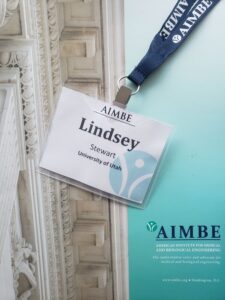
The mission of the American Institute for Medical and Biological Engineering (AIMBE) is “to provide leadership and advocacy in medical and biological engineering for the benefit of society.” To progress this mission, the AIMBE Public Policy Institute for Rising Leaders allows students to learn from key players in medical innovation regulation about how public policy impacts biomedical engineering. As students engaged in multidisciplinary research and study throughout the country, we learned the significance of bridging the distance between science, engineering, and policy making.
Over the course of two days, lecturers presented from a wide scope of organizations, from health specific organizations such as the FDA and NIH, to policymakers such as the Staff Director for the Research and Technology Subcommittee of the House Committee on Science, Space, and Technology. 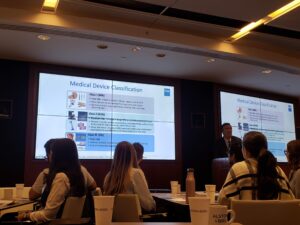 The importance of trust and communication between the public, scientists, and policymakers were heavily emphasized throughout the workshop. We had time to network with one another to discuss how and why we should each be advocates for science. We learned and discussed health equity and how health policy and advocacy can impact inequity across the nation. Hearing from other students’ experiences was extremely powerful in understanding the need for ever increasing initiatives to assist in providing care to those in need. We also focused on the role that research can play in public policy through careers based in government health organizations as well as advocacy through industry and academia.
The importance of trust and communication between the public, scientists, and policymakers were heavily emphasized throughout the workshop. We had time to network with one another to discuss how and why we should each be advocates for science. We learned and discussed health equity and how health policy and advocacy can impact inequity across the nation. Hearing from other students’ experiences was extremely powerful in understanding the need for ever increasing initiatives to assist in providing care to those in need. We also focused on the role that research can play in public policy through careers based in government health organizations as well as advocacy through industry and academia.
Personally, I felt that the most important lessons I learned were about communication
regarding public support for health policy. Nat Kendall-Taylor, chief executive officer of the Frameworks Institute, presented five ways we can present information in a way that will influence how people think, feel, and act about certain issues. The most notable of these were the invitations to show instead of tell, as well as the need to balance urgency with efficacy. As scientists communicating with the public and policy makers, we need to learn the skill of explanation over assertion. Rather than telling others what they should think, we need to use the “superpower” of explanation to connect issues to solutions. As confidence in understanding increases, people are more likely to analyze what needs to be done and support initiatives and policy on medical innovation that work toward a solution. 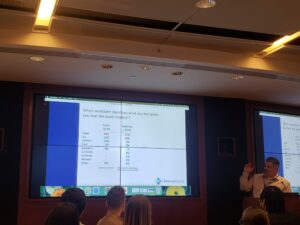 Likewise, when communicating science, urgency is not enough to evoke action. There needs to be a balance with efficacy to allow progress to be made. If there is high urgency with low efficacy, the result is a sense of fatalism with a lack of trust in the institution of science. If there is high efficacy with low urgency, motivation for progression is low. However, if we are able to balance high urgency with high efficacy, there is a sense of empowerment that enables action on important issues such as the funding of science initiatives directed toward increasing our health and wellbeing.
Likewise, when communicating science, urgency is not enough to evoke action. There needs to be a balance with efficacy to allow progress to be made. If there is high urgency with low efficacy, the result is a sense of fatalism with a lack of trust in the institution of science. If there is high efficacy with low urgency, motivation for progression is low. However, if we are able to balance high urgency with high efficacy, there is a sense of empowerment that enables action on important issues such as the funding of science initiatives directed toward increasing our health and wellbeing.
The concluding speaker of the event was the executive director of ScienceCounts, a non-profit organization seeking to enhance public awareness of, and support for, scientific
research. He provided information from multiple studies regarding how the public perceives science versus how scientists perceive science. In repeated studies, the word that the public most commonly associated with science was “hope.” In similar studies, scientists most commonly associated science with the word “joy.” In order to continue to bring hope to the public, science must progress. This requires public support for health policy for funding to continue to perpetuate research.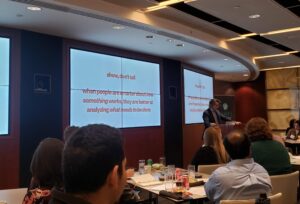
Therefore, it is our responsibility as scientists and engineers to learn to effectively communicate our science. AIMBE’s Public Policy Institute has shown me how crucial it is to bridge academia, industry, and government. Only through networking to work together and speaking out to educate those around us are we able to progress science. The public needs medical innovation, and medical innovation needs the public; this is why we must learn to communicate and trust each other to work toward a healthier future.